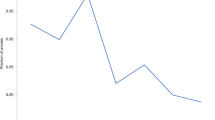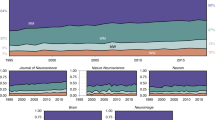Abstract
Despite an unprecedented number of women entering neuroscience, and decades-long recruitment and retention efforts, women continue to be disproportionately underrepresented in European academic tenure-track faculty and leadership positions. This Perspective focuses on two major career points where women exhibit diminished representation: the transition from postdoctoral fellow to junior professor and the promotion to more senior (tenured) faculty positions. We discuss below recently implemented country-specific and Europe-wide initiatives supporting equal career progression and propose further concrete steps to be taken to break down the structural barriers that prevent women’s progression up the academic career ladder as European neuroscientists.
This is a preview of subscription content, access via your institution
Access options
Access Nature and 54 other Nature Portfolio journals
Get Nature+, our best-value online-access subscription
$29.99 / 30 days
cancel any time
Subscribe to this journal
Receive 12 print issues and online access
$209.00 per year
only $17.42 per issue
Buy this article
- Purchase on Springer Link
- Instant access to full article PDF
Prices may be subject to local taxes which are calculated during checkout


Similar content being viewed by others
Data availability
The data in Fig. 1 come from two sources. The GCI information, the percentage of European women per academic position and the percentage of women among grade A (full) professors by country in the natural sciences are taken from the report She Figures 2021 (European Commision, 2021a; source: Women in Science database, DG Research and Innovation – T1_questionnaires). The dataset of FENS members was obtained via personal communication with the FENS Office and represents FENS members as of February 2023. We note that only 3,223 of 20,865 members provided information on their position and gender; these data are used in this plot. The data in Fig. 2 come from two separate publicly available datasets (online data codes: lfst_hheredty, ilc_caparents) from Eurostat, the statistical office of the European Union (https://ec.europa.eu/eurostat). The ‘employment impact’ was calculated by subtracting the employment rates of women with children from the employment rates of women without children.
References
European Commission, Directorate-General for Research and Innovation. She Figures 2021: Gender in Research and Innovation: Statistics and Indicators (Publications Office, 2021); https://data.europa.eu/doi/10.2777/06090 (accessed 07 September 2023).
National Center for Science and Engineering Statistics, National Science Foundation. Doctorate Recipients from US Universities 2021 (National Science Foundation 23-300, 2022); https://ncses.nsf.gov/pubs/nsf23300 (accessed 07 September 2023).
National Center for Science and Engineering Statistics (NCSES). Survey of Graduate Students and Postdoctorates in Science and Engineering (National Science Foundation, 2023); https://ncses.nsf.gov/pubs/nsf23312 (accessed 07 September 2023).
McKinley Advisors. Report of Neuroscience Departments & Programs Survey (Academic Year 2016–2017) (Society for Neuroscience, 2017); https://www.sfn.org/-/media/SfN/Documents/Survey-Reports/NDP-Final-Report.ashx%20 (accessed 09 August 2023).
European Research Area and Innovation Committee - Standing Working Group on Gender in Research and Innovation. Report by the ERAC SWG on Gender in Research and Innovation on Gender Equality Plans as a Catalyst for Change (ERAC-SWG, 2021); https://data.consilium.europa.eu/doc/document/ST-1202-2021-INIT/en/pdf (accessed 09 August 2023).
Cyr, E. C., Bergsieker, H. B., Dennehy, T. C. & Schmader, T. Mapping social exclusion in STEM to men’s implicit bias and women’s career costs. Proc. Natl Acad. Sci. USA 118, e2026308118 (2021).
Llorens, A. et al. Gender bias in academia: a lifetime problem that needs solutions. Neuron 109, 2047–2074 (2021).
European Molecular Biology Organization. 2021 Facts Figures with Annual Report (EMBO, 2022); https://www.embo.org/documents/news/facts_figures/EMBO_facts_figures_2021.pdf (accessed 09 August 2023).
Human Frontier Science Program. Annual report 1 April 2021–31 March 2022 (HFSP, 2022); https://www.hfsp.org/sites/default/files/2022-08/HFSP%20Annual%20Report%20FY%202021%20for%20web.pdf (accessed 09 August 2023).
Huang, J., Gates, A. J., Sinatra, R. & Barabási, A. -L. Historical comparison of gender inequality in scientific careers across countries and disciplines. Proc. Natl Acad. Sci. USA 117, 4609–4616 (2020).
Martinez, E. D. et al. Falling off the academic bandwagon: women are more likely to quit at the postdoc to principal investigator transition. EMBO Rep. 8, 977–981 (2007).
Campaña, J. C., Gimenez-Nadal, J. I. & Velilla, J. Measuring gender gaps in time allocation in Europe. Soc. Indic. Res. 165, 519–553 (2022).
Zheng, X., Yuan, H. & Ni, C. How parenthood contributes to gender gaps in academia. eLife 11, e78909 (2022).
Lambert, W. M. et al. Career choices of underrepresented and female postdocs in the biomedical sciences. eLife 9, e48774 (2020).
Moors, A. C., Malley, J. E. & Stewart, A. J. My family matters: gender and perceived support for family commitments and satisfaction in academia among postdocs and faculty in STEMM and non-STEMM fields. Psychol. Women Q. 38, 460–474 (2014).
Moors, A. C., Stewart, A. J. & Malley, J. E. Managing the career effects of discrimination and motherhood: the role of collegial support for a caregiving policy at a research-intensive US university. J. High. Educ. Policy Manag. 44, 377–392 (2022).
Wynn, A. T., Fassiotto, M., Simard, C., Raymond, J. L. & Valantine, H. Pulled in too many directions: the causes and consequences of work–work conflict. Sociol. Perspect. 61, 830–849 (2018).
Fassiotto, M., Simard, C., Sandborg, C., Valantine, H. & Raymond, J. An integrated career coaching and time-banking system promoting flexibility, wellness, and success: a pilot program at Stanford University School of Medicine. Acad. Med. 93, 881–887 (2018).
European Union. Directive (EU) 2019/1158 of the European Parliament and of the Council of 20 June 2019 on work–life balance for parents and carers and repealing Council Directive 2010/18/EU, PE/20/2019/REV/1 (2019); https://eur-lex.europa.eu/legal-content/EN/TXT/?uri=celex%3A32019L1158 (accessed 09 August 2023).
European Commission. Communication from the Commission to the European Parliament, the Council, the European Economic and Social Committee and the Committee of the Regions, ‘A Union of Equality: Gender Equality Strategy 2020–2025’ (2020); https://eur-lex.europa.eu/legal-content/EN/TXT/?uri=CELEX%3A52020DC0152 (accessed 09 August 2023).
Leitner, S. in Gender and Family in European Economic Policy: Developments in the New Millennium (eds Auth, D. et al.) 111–128 (Springer International Publishing, 2017).
Lagesen, V. A., Kristensen, G. K., Sørensen, S. Ø. and Matsuda, D. in Comparative Perspectives on Gender Equality in Japan and Norway: Same But Different? (eds Ishii-Kuntz, M. et al.) 104–120 (Routledge, 2021).
Ecklund, E. H., Damaske, S., Lincoln, A. E. & White, V. Johnston Strategies men use to negotiate family and science. Socius https://doi.org/10.1177/2378023116684516 (2017).
Farre, L., Felfe, C., Gonzalez, L. & Schneider P. IZA Discussion Paper no. 16341 https://doi.org/10.2139/ssrn.4526266 (2022).
Felfe, C. & Lalive, R. Does early child care affect ’children’s development. J. Public Econ. 159, 33–53 (2018).
AAAS Cell Associates. Barriers for Women Scientists Survey Report (AAAS, 2010); https://www.aaas.org/sites/default/files/0928loreal_survey_report.pdf (accessed 09 August 2023).
Rivera, L. A. When two bodies are (not) a problem: gender and relationship status discrimination in academic hiring. Am. Sociol. Rev. 82, 1111–1138 (2017).
Rudman, L. A., Moss-Racusin, C. A., Phelan, J. E. & Nauts, S. Status incongruity and backlash effects: defending the gender hierarchy motivates prejudice against female leaders. J. Exp. Soc. Psychol. 48, 165–179 (2012).
Heilman, M. E., Wallen, A. S., Fuchs, D. & Tamkins, M. M. Penalties for success: reactions to women who succeed at male gender-typed tasks. J. Appl. Psychol. 89, 416–427 (2004).
Abbott, A. Scientists question Max Planck Society’s treatment of women leaders. Nature 600, 20 (2021).
Tinkler, J., Zhao, J., Li, Y. & Ridgeway, C. L. Honorary Whites? Asian American women and the dominance penalty. Socius 5, https://doi.org/10.1177/2378023119836000 (2019).
Chatman, J. A., Sharps, D., Mishra, S., Kray, L. J. & North, M. S. Agentic but not warm: age–gender interactions and the consequences of stereotype incongruity perceptions for middle-aged professional women. Organ. Behav. Hum. Decis. Process. 173, 104190 (2022).
Lawson, A. M., Martin, A. E., Huda, I. & Matz, S. C. Hiring women into senior leadership positions is associated with a reduction in gender stereotypes in organizational language. Proc. Natl Acad. Sci. USA 119, e2026443119 (2022).
European Commission. Directorate-General for Research and Innovation, She Figures 2021: Policy Briefs (Publications Office, 2021); https://data.europa.eu/doi/10.2777/078011 (accessed 07 September 2023).
Correll, S. J. SWS 2016 Feminist Lecture: reducing gender biases in modern workplaces: a small wins approach to organizational change. Gend. Soc. 31, 725–750 (2017).
Heilman, M. E. Gender stereotypes and workplace bias. Res. Organ. Behav. 32, 113–135 (2012).
Heijstra, T. M., Einarsdóttir, Þ, Pétursdóttir, G. M. & Steinþórsdóttir, F. S. Testing the concept of academic housework in a European setting: part of academic career making or gendered barrier to the top?. Eur. Educ. Res. J. 16, 200–214 (2017).
O’Meara, K., Kuvaeva, A., Nyunt, G., Waugaman, C. & Jackson, R. Asked more often: gender differences in faculty workload in research universities and the work interactions that shape them. Am. Educ. Res. J. 54, 1154–1186 (2017).
Barrett, L. & Barrett, P. Women and academic workloads: career slow lane or cul-de-sac. High. Educ. 61, 141–155 (2011).
National Academy of Sciences, Engineering, and Medicine. To prevent sexual harassment, academic institutions should go beyond legal compliance to promote a change in culture; current approaches have not led to decline in harassment (2018); https://www.nationalacademies.org/news/2018/06/to-prevent-sexual-harassment-academic-institutions-should-go-beyond-legal-compliance-to-promote-a-change-in-culture-current-approaches-have-not-led-to-decline-in-harassment (accessed 9 August 2023).
IPSOS. Harcèlement Sexuel et Sexisme au Sein du Monde Scientifique (2023); https://www.ipsos.com/sites/default/files/ct/news/documents/2023-03/Ipsos-Fondation-Loreal-Harcelement-Sexisme-monde-scientifique.pdf (accessed 9 August 2023).
Greider, C. W. et al. Increasing gender diversity in the STEM research workforce. Science 366, 692–695 (2019).
Warren, M. A. & Bordoloi, S. D. Going beyond good colleagues: men’s and women’s perspectives on allyship behaviors toward women faculty in male-dominated disciplines in academia. J. Divers. Higher Educ., https://doi.org/10.1037/dhe0000369 (2021).
Ünver, Ö., Bircan, T. & Nicaise, I. Perceived accessibility of childcare in Europe: a cross-country multilevel study. Int. J. Child Care Educ. Policy 12, 5 (2018).
Acknowledgements
We acknowledge the influence of our personal biases and privileges on the shaping of this manuscript, and we apologize for any oversights or omissions. We thank A. Barker, G. Laurent and V. Stempel for suggestions and comments. We thank FENS and T. Asakawa for providing us with anonymized membership data. The laboratory of E.M.S. is supported by the Max Planck Society and the European Union (ERC, DiverseSynapse, 101054512). A.M.B. is supported by an EMBO Long-Term Fellowship (ALT 238–2021). Views and opinions expressed are those of the authors only and do not necessarily reflect those of the Max Planck Society, the European Union or the European Research Council. Neither the European Union nor the granting authority can be held responsible for them.
Author information
Authors and Affiliations
Corresponding author
Ethics declarations
Competing interests
The authors declare no competing interests.
Peer review
Peer review information
Nature Neuroscience thanks Gerlind Wallon and the other, anonymous, reviewer(s) for their contribution to the peer review of this work.
Additional information
Publisher’s note Springer Nature remains neutral with regard to jurisdictional claims in published maps and institutional affiliations.
Rights and permissions
Springer Nature or its licensor (e.g. a society or other partner) holds exclusive rights to this article under a publishing agreement with the author(s) or other rightsholder(s); author self-archiving of the accepted manuscript version of this article is solely governed by the terms of such publishing agreement and applicable law.
About this article
Cite this article
Bourke, A.M., Spanò, T. & Schuman, E.M. A European perspective on structural barriers to women’s career progression in neuroscience. Nat Neurosci 26, 1842–1847 (2023). https://doi.org/10.1038/s41593-023-01467-5
Received:
Accepted:
Published:
Issue Date:
DOI: https://doi.org/10.1038/s41593-023-01467-5



